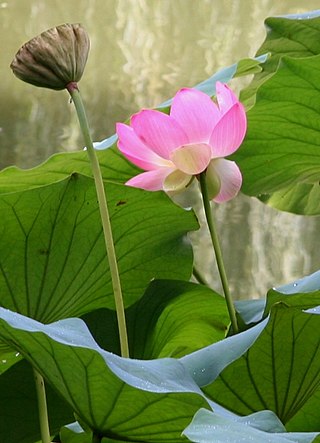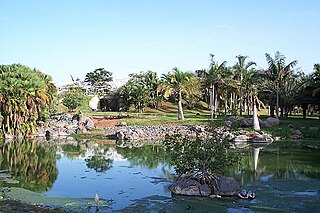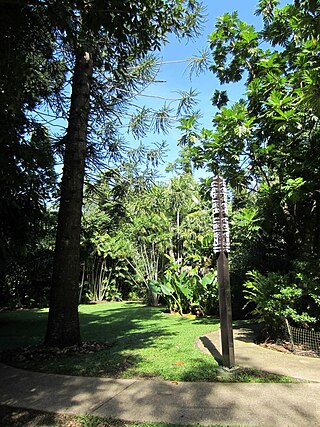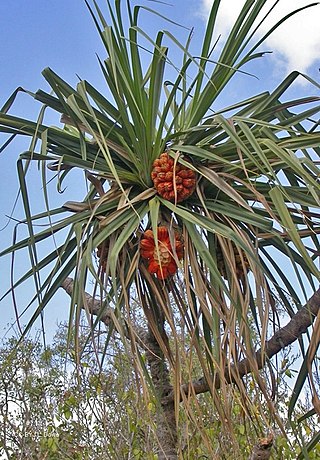
Cape York Peninsula is a peninsula located in Far North Queensland, Australia. It is the largest wilderness in northern Australia. The land is mostly flat and about half of the area is used for grazing cattle. The relatively undisturbed eucalyptus-wooded savannahs, tropical rainforests and other types of habitat are now recognised and preserved for their global environmental significance. Although much of the peninsula remains pristine, with a diverse repertoire of endemic flora and fauna, some of its wildlife may be threatened by industry and overgrazing as well as introduced species and weeds.

The City Botanic Gardens is a heritage-listed botanic garden on Alice Street, Brisbane City, City of Brisbane, Queensland, Australia. It was also known as Queen's Park. It is located on Gardens Point in the Brisbane CBD and is bordered by the Brisbane River, Alice Street, George Street, Parliament House and Queensland University of Technology's Gardens Point campus. It was established in 1825 as a farm for the Moreton Bay penal settlement.

Pandanus is a genus of monocots with some 578 accepted species. They are palm-like, dioecious trees and shrubs native to the Old World tropics and subtropics. The greatest number of species are found in Madagascar and Malaysia. Common names include pandan, screw palm and screw pine. They are classified in the order Pandanales, family Pandanaceae.

Fairchild Tropical Botanic Garden is an 83-acre (34 ha) botanic garden with extensive collections of rare tropical plants including palms, cycads, flowering trees, and vines. It is located in the city of Coral Gables, Miami-Dade County, just south of Miami, surrounded at the north and west by Matheson Hammock Park.

The Harry P. Leu Gardens are semi-tropical and tropical gardens in Orlando, Florida, United States. The gardens contain nearly 50 acres (200,000 m2) of landscaped grounds and lakes, with trails shaded by 200-year-old oaks and forests of camellias. They are open to the public. The address is 1920 North Forest Avenue Orlando, FL 32803.

The Wahiawa Botanical Garden, 27 acres (11 ha) is a botanical garden on a high plateau in central Oʻahu, Hawaiʻi, United States, located between the Wai'anae and Ko'olau mountain ranges. It is one of the Honolulu Botanical Gardens, and home to a collection of tropical flora requiring a relatively cool environment, with emphasis on native Hawaiian plants. It is nicknamed the "tropical jewel" of the Botanical Gardens. The Garden's site began in the 1920s, when the Hawaiian Sugar Planters' Association leased land from the State of Hawaiʻi for experimental tree planting. Most of the Garden's large trees date from that era. The property was transferred to Honolulu in 1950, and opened as a botanical garden in 1957. It is open seven days a week, from 9am to 4 pm.

Pandanus tectorius is a species of Pandanus (screwpine) that is native to Malesia, Papuasia, eastern Australia, and the Pacific Islands. It grows in the coastal lowlands typically near the edge of the ocean. Common names in English include thatch screwpine, Tahitian screwpine, hala tree and pandanus. The fruit is edible and sometimes known as hala fruit.

Bowen Park is a heritage-listed park of 17,740 square metres (191,000 sq ft) at O'Connell Terrace, Bowen Hills, City of Brisbane, Queensland, Australia. It was built from 1863 to 1950s. It was also known as the Acclimatisation Society Gardens. It was added to the Queensland Heritage Register on 26 February 1999.

Ganna Walska Lotusland, also known as Lotusland, is a non-profit botanical garden located in Montecito, near Santa Barbara, California, United States. The garden is the historic estate of Madame Ganna Walska. The County of Santa Barbara restricts visitation via a conditional use permit: Lotusland botanic garden is open to the public by reservation only, with walking tours 1½ to 2 hours long.

Archontophoenix alexandrae, commonly known as Alexandra palm, king palm, northern Bangalow palm, or feather palm, is a palm endemic to Queensland, Australia. It was named in honour of Princess Alexandra of Denmark, but is often erroneously referred to by the misnomer Alexander palm.

The Palmetum of Santa Cruz de Tenerife is a botanical garden of 120.000 m² specialized in palms (Arecaceae). It is an artificial hill, with views of the ocean, located in Santa Cruz de Tenerife, Canary Islands, Spain. The gardens include a large system of waterfalls, streams and ponds, a museum dedicated to palms, and a display shade house. The project was started in 1995 on a former landfill and only opened to the public in 2014. The valuable palm collection gathers about 600 species of palms and it is focused on the ones native to world islands. Trees and shrubs of other plant families are also displayed, organised in "biogeographical sections". All gardens are maintained with no pesticides and no fertilizers, different species of wild birds are easily seen in the palmetum.
The wildlife of Mauritius consists of its flora and fauna. Mauritius is located in the Indian Ocean to the east of Madagascar. Due to its isolation, it has a relatively low diversity of wildlife; however, a high proportion of these are endemic species occurring nowhere else in the world. Many of these are now threatened with extinction because of human activities including habitat destruction and the introduction of non-native species. Some have already become extinct, most famously the dodo which disappeared in the 17th century.

Wodyetia bifurcata, the foxtail palm, is a species of palm in the family Arecaceae, native to Queensland, Australia. It is the sole species in the genus Wodyetia.

Queens Gardens is a large heritage-listed botanic garden at Paxton Street, North Ward, City of Townsville, Queensland, Australia. Queens Gardens is located at the base of Castle Hill, near to both the city centre and The Strand beachside park. It has been called Townsville's finest park. It was added to the Queensland Heritage Register on 14 August 2008.

Archontophoenix cunninghamiana – commonly known as Bangalow palm, king palm, Illawara palm or piccabeen palm – is a tree in the palm family Arecaceae which is endemic to the east coast of New South Wales and Queensland, Australia.

Flecker Botanic Gardens is a heritage-listed botanic garden at Collins Avenue, Edge Hill, Queensland, Australia. It was built from 1886 to 1960s. It is now known as Cairns Botanic Gardens, and also known as Edge Hill Nursery, and Fitzalan's Botanical Gardens. It was added to the Queensland Heritage Register on 2 February 2007.
Memecylon pauciflorum is a tree species in the Melastomataceae family. It grows as a tree or shrub in northern Australia and tropical and subtropical Asia. An understorey species typically, it grows in a variety of communities. The possum Petropseudes dahli uses this species as one of their scent-marking sites. It is a host to a number of funguses. People in Australia and in Thailand use the plant in folk medicine, though no efficacy has been demonstrated.

Pandanus gemmifer, commonly known as pup pandan, is a plant in the family Pandanaceae that is endemic to northeast Queensland. It is closely related to Pandanus grayorum and Pandanus solms-laubachii.

Pandanus solms-laubachii, commonly known as the swamp pandan, is a small tree in the family Pandanaceae which occurs in northeastern Queensland and possibly in Papua New Guinea. It is closely related to both Pandanus gemmifer and Pandanus grayorum.

Pandanus cookii, commonly known as Cook's pandan, Cook's screwpine or simply screwpine, is a tree in the family Pandanaceae which is endemic to coastal and sub-coastal parts of tropical Queensland, Australia. It grows to around 10 m (33 ft) in height with an open habit, long narrow leaves up to 180 by 8 cm and prop roots up to around 30 cm (12 in) long.


















